Canon PowerShot A3000 IS / A3100 IS
-
-
Written by Gordon Laing
Intro
The Canon PowerShot A3100 IS is an affordable 12.1 Megapixel compact with a stabilized 4x zoom lens and 2.7in LCD screen. Launched in January 2010 it replaces the best-selling PowerShot A1100 IS with a radical redesign of the body and controls. Most notably, it’s the first PowerShot A Series to use a Lithium-Ion power pack. Canon has abandoned AA batteries for this model, opting instead for a new NB-8L Lithium-Ion battery. The earlier A1100’s optical viewfinder has also been dropped in favour of a slightly larger 2.7in LCD panel, and the new model also supports the SDXC standard for bigger memory cards.
Launched alongside the PowerShot A3100 IS is the PowerShot A3000 IS. This model is identical other than having a slightly lower resolution 10 Megapixel sensor, and only being available in a silver finish – the A3100 IS is available in silver, blue or red, and of course has those two extra Megapixels of resolution. Note in the UK, the A3000 IS is only available from Argos. Aside from a minor reduction in resolution, everything we say about the A3100 IS also applies to the A3000 IS, so where both models are the same, we’ll describe them as the A3000 IS / A3100 IS.
Is a makeover and a switch of power source going to be enough to maintain this model’s position as one of the most popular compacts in its price range? And does it still provide excellent value for money in a market where competition is extremely keen? To find out we tested the PowerShot A3000 IS / A3100 IS alongside two other affordable compacts.
The first of these was Canon’s own PowerShot A490 / A495, launched alongside the A3000 IS / A3100 IS. Though lacking some of the A3000 IS / A3100 IS’s stand-out features, the PowerShot A490 / A495 is nonetheless a very capable budget compact. Our second model for comparison was the even cheaper Nikon COOLPIX L22, successor to the best-selling L20. The L22 almost looks too good to be true, matching the A3100 IS on resolution, coming close on zoom range and beating it on LCD size. But how does it compare for image quality and is its lack of manual control a help, or a hindrance. Read our full review to find out how this latest batch of affordable compacts measures-up.
The new PowerShot A3000 IS / A3100 IS is no smaller or lighter than the A1100 IS it replaces, but the new styling makes it look so. Gone is the asymmetrical bulbous right end, replaced with a less aggressive fluted design with a dished top panel and a front plate that flares slightly at the right end to accommodate a cylindrical column with the mode selector at the top. It all looks a little classier and less business-like than its predecessor.
We liked the security the earlier A1100’s big round grip provided, but after a few minutes of use, the PowerShot A3000 IS / A3100 IS feels good whether held single-handed or with both hands. Your thumbs and index fingers fall naturally into place with the remaining fingers of your right hand resting comfortably out of the way on the flared edge of the front panel.
We’re not convinced the location of the mode dial on the right corner of the camera is a good idea though. Despite the fact half of its knurled rim is exposed on the outer edge, it’s infernally difficult to switch positions – your fingers just slide around it. To make it work requires pressure inwards with both index finger and thumb while rotating at the same time. On the plus side, this means there’s little chance of it moving accidentally while slipping the camera in and out of your pocket.
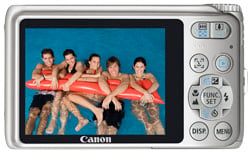 |
The on/off button is located next to the shutter release in the recessed top panel, but there’s little chance of mistaking one for the other as the shutter button is bigger and protrudes more. The zoom collar, previously on the shutter release, is replaced with a thumb-operated rocker switch at the top of the rear panel, below which is the familiar Canon control disc surrounded by buttons for face selection, playback mode, display overlays and menus.
|
The back panel has one button fewer than the PowerShot A1100 IS and its absence may or may not be of consequence to you, depending on how keen you are on changing camera settings whilst shooting. The lack of a direct print button isn’t in itself much to get worked up about – unless of course you’re one of those people who likes to connect their compact directly to a printer, rather than going via a PC. But the A1100’s direct print button doubled up as a configurable one-touch button for all sorts of settings from manual ISO to red-eye correction and it was great to be able to custom configure the hardware in this way.
In it’s absence, it’s only fair to say, frequently-used settings on the PowerShot A3000 IS / A3100 IS are still very accessible. The Func Set button at the centre of the control disc gives you instant access to ISO sensitivity, white balance, colour rendering modes, metering modes, continuous shooting, and size and compression settings in the exposure modes that support them.
The surrounding control disc – redesigned to look more like a cross – provides one-touch access for exposure compensation, flash settings, self-timer functions and macro focussing.
The PowerShot A3000 IS / A3100 IS has a built-in flash unit located at the top left corner of the front panel. According the the manual it has a maximum range of four metres with the lens set at its widest focal length. One of the failings of older AA-powered A Series PowerShots was the slow recycling time of the flash, which could take up to seven seconds to recharge between flash shots. Happily, the switch to a Lithium-Ion battery has resolved this problem, the PowerShot A3000 IS / A3100 IS flash takes a little under three seconds to recycle and you can even use it with the flash in continuous shooting mode – managing fractionally under one frame every two seconds.
In Auto mode the flash fires when required. You can also force it to fire, switch it off or use it in Slow Synchro mode for fill-in illumination. The A3000 IS / A3100 IS features Smart Flash Exposure, which intelligently adjusts flash exposure to suit the subject and the shooting conditions. Smart Flash comes into play in daylight shots, filling-in to avoid facial shadows in portraits for example, as well as during macro shooting, preventing over-exposure.
As we’ve said, this is the first A series PowerShot to abandon AA batteries in favour of a proprietary Li-Ion cell, in this case Canon’s NB-8L. Whatever your feelings about the price and convenience of AAs vs proprietary Li-ion batteries, there’s no arguing with the positive effect the switch has had on the flash-recycling of the PowerShot A3000 IS / A3100 IS. In general use though, the new pack won’t last as long as similar models powered by AAs. Under CIPA conditions, PowerShot A3000 IS / A3100 IS is capable of taking 240 shots on a fully charged battery. That’s considerably fewer than the older A1100 IS, the new A490 IS / A495 IS or the Nikon COOLPIX L22 can manage with a pair of NiMH cells. You also no longer have the convenience of being able to pick-up a spare set AAs when running low on power. Instead you’ll either need to invest in a spare NB-8L, or find a power outlet.
Like most 2010 compacts, the PowerShot A3000 IS / A3100 IS supports the latest SDXC format for memory cards larger than 32GB. The older SDHC and original SD formats are still supported.
Canon PowerShot A3000 IS / A3100 IS coverage wide |
Canon PowerShot A3000 IS / A3100 IS coverage tele | |
 | 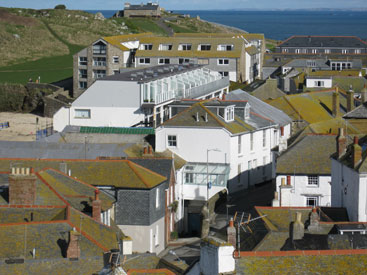 | |
| 6.2-24.8mm at 6.2mm (35mm equivalent) | 6.2-24.8mm at 24.8mm (140mm equivalent) |
The PowerShot A3000 IS / A3100 IS’s 4x optical zoom lens has a range of 6.2-24.8mm which, in 35mm terms is 35mm-140mm. Its maximum aperture ranges from f2.7-5.5 depending on the focal length. For a camera in this price range A 4x zoom is becoming the de facto standard. What tends to vary is the start and end point and, though you’ll find some cameras that start wider and others that go longer, we think the PowerShot A3000 IS / A3100 IS provides a good balance between a usable wide-angle and capable short telephoto.
On power-up the lens extends by 24mm and the camera is ready for action in a fraction under two seconds – not lightning fast, but good enough for most situations. The zoom motor covers the full distance in about one and half seconds. You can nudge the zoom through seven discrete steps in either direction, which may not deliver as much fine control as many compact zooms, but again, it’s good enough for most situations.
Canon PowerShot A3000 IS / A3100 IS: IS off / continuous | ||
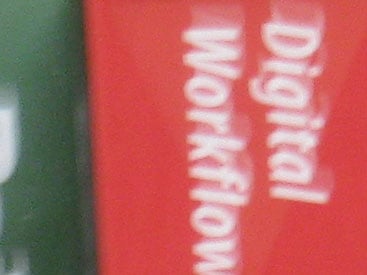 | 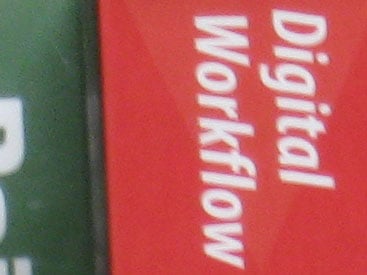 | |
100% crop, 6.2-24.8mm at 24.8mm, 1/10, 100 ISO, IS off |
100% crop, 6.2-24.8mm at 24.8mm, 1/10, 100 ISO, IS on | |
The PowerShot A3000 IS / A3100 IS uses Canon’s optical image stabilization system which compensates for camera movement at slow shutter speeds by shifting lens elements to steady the image received by the sensor.
The photographer’s rule of thumb for avoiding camera shake states that you should use a minimum shutter speed of one over the equivalent focal length of the lens. The two crops above are from shots taken with the PowerShot A3000 IS / A3100 IS with the lens zoomed to its maximum of 140mm (equivalent). At this focal length, you’d expect to see camera-shake in shots taken at shutter speeds slower than 1/140 of a second. The crop on the right is from a shot taken with IS in continuous mode, the one on the left with IS off. The PowerShot A3000 IS / A3100 IS has managed to produce a sharp shot with little or no camera shake at a shutter speed of 1/10 of a second, this is pretty impressive, amounting to close-on four stops of image stabilisation.
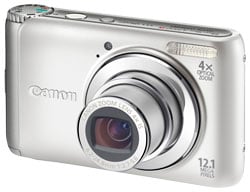 |
|
The PowerShot A3000 IS / A3100 IS has two Auto Focus modes, Face AiAF and Center. In the default Face AiAF mode, the camera detects when there are faces in the frame, outlining the main subject with a white frame and two additional subjects with grey frames. You can change the main subject using the Face selector button on the rear panel. Then, when you press the shutter button half-way green frames appear on up to nine faces. If there are no faces in the frame the camera defaults to Canon’s nine-area AF system.
Canon’s Face AiAF system is one of the best around. In good lighting it’s quick to detect and lock onto faces and its tracking is very sticky – once it has a face in its sights it won’t easily lose it, even if it turns almost to full profile. Like all autofocus systems it’s less sure of itself in poor light, being slower to react and quicker to lose track. But if you take a lot of people shots there’s no doubt it will significantly increase your chances of getting a pin sharp snap.
There’s also a single centre frame AF mode which focuses on a central area which can be set to one of two sizes. Used in combination with focus locking – holding down the shutter button half way to temporarily lock the focus or AF lock – pressing the right disc controller button to lock the focus permanently, provides a quick and effective alternative to the default AF system.
The PowerShot A3000 IS / A3100 IS has a 2.7in LCD panel with 230k pixels. While there’s nothing jaw-dropping about that in terms of current specifications, it’s a big jump from the smaller and coarser 2.5in / 115k screen of its predecessor. In use it delivers a clear, bright, contrasty image that’s viewable at most angles. Like all LCD screens it’s of limited use in bright sunlight and in the absence of an optical viewfinder you just have to do what you can to provide some shade with your hand.
It’s worth remembering the earlier A1100 IS sported an optical viewfinder, and many will be sad to see it go on the new models in favour of a bigger, more detailed screen. But bigger screens are easier to market on the shelves, and it’s a trend we’ll undoubtedly see more of.
We’ve already talked about the Func Set button which provides quick access to the most commonly used camera settings. In addition the PowerShot A3000 IS / A3100 IS provides a menu system arranged on two tabs which is activated by pressing the Menu button at the bottom of the rear control panel.
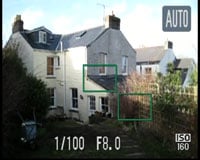 |
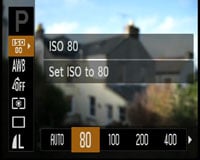 |
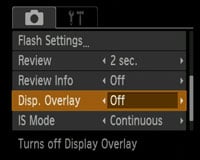 |
In shooting modes, the two menus list all the available camera settings on one tab and shooting settings on the other. Canon’s recently introduced Hints & Tips feature provides a brief explanation of the function of each setting as you select it using the control disc.
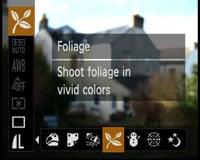 |
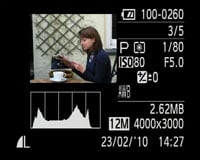 |
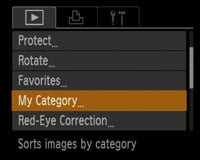 |
Camera Settings mostly contains the kind of things you set once then forget, like sound options, LCD brightness and power saving settings, it’s also where you go to format cards. Shooting settings includes AF mode, digital zoom, red-eye correction, display overlays, and image stabilization.
In playback mode the camera settings tab is joined by print settings and a slideshow menu which also includes category tagging features and some basic in-camera editing options.
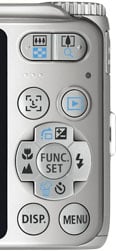 |
The PowerShot A3000 IS / A3100 IS is a fully automatic compact. Although in Program mode it allows you set the ISO sensitivity and some other settings, exposure control is fully automatic. In Auto mode the camera uses Canon’s Intelligent Auto system which employs scene detection to figure-out what you’re trying to photograph.
Canon’s scene detection determines whether there are people in the scene, whether it includes blue skies, if the subject is backlit, how close the subject is and whether it’s day or night. An icon appears in the top right of the screen to tell you what the camera thinks it’s looking at – and it usually (though not always) gets it right.
Intelligent Auto is also at the heart of Easy mode – a version of Auto mode which disables virtually all user-selectable functions and turns the PowerShot A3000 IS / A3100 IS into an idiot-proof point-and-shoot automatic. In Easy mode you can use the zoom and toggle the flash between auto and off, that’s it. The camera operates in Face AiAF mode, but the face select button is disabled, as is the Func Set button, the menu button, the self-timer and everything else bar the playback button.
The mode dial has five dedicated scene buttons – Portrait, Landscape, Night Snapshot, Kids & Pets and Indoor, followed by a generic scene mode button which activates the currently selected scene mode. These are chosen using the Func Set button to choose from nine options including Beach, Foliage, Snow and Fireworks. There’s also Face Self-timer which automatically activates the self-timer count-down when a new face enters the frame, saving you the effort of pressing the shutter and making a dash for it, and a new Low Light mode which shoots a 2 Megapixel image at 1600 ISO.
The PowerShot A3000 IS / A3100 IS is price-wise right on the edge of where you’d expect to find HD movie recording, but falls the wrong side of the divide with only standard definition video. If you want a Canon compact with HD video recording at or around this price you’ll need to look at the IXUS 100 IS / SD780 IS or the slightly pricier IXUS 120 IS / SD940 IS.
In the meantime, the A3000 IS / A3100 IS shoots movies at a maximum resolution of 640×480 pixels at 30 frames per second. There’s also a long play option at the same resolution and frame rate which applies stronger compression to squeeze twice the footage into the same file size, and a 320×240 pixel 30fps option.
Like Canon’s older or cheaper compacts, movie files are compressed with Motion JPEG and stored in an AVI wrapper with an average bitrate of 15 Megabits per second at the best quality setting. The maximum recording time is one hour or as soon as the file reaches 4GB in size. Once you start filming, the optical zoom annoyingly becomes locked, with only an increasingly pixelated digital zoom at your disposal. Registered members of Vimeo can download the clip shown here.
The documentation claims a rate of 0.8 frames per second in continuous shooting mode, but in our tests the PowerShot A3000 IS / A3100 IS did marginally better than that, managing a steady 0.9fps at the highest resolution and quality setting. Reducing the image size didn’t affect the continuous shooting frame rate. The manual also specifies a ‘Low Light’ continuous shooting frame rate of 2.6 frames per second and that’s exactly what we got in testing with the camera set to the 2 Megapixel Low Light scene mode. As we’ve already seen, when using the flash the PowerShot A3000 IS / A3100 IS can shoot continuously at a rate of 0.4 frames per second for 20 frames.
Other than the available finish, the only difference between the PowerShot A3000 IS and the A3100 IS is their resolution. Both models employ 1/ 2.3in CCD sensors, but the A3000 IS has 10 Megapixels compared to 12.1 on the A3100 IS. This translates into maximum image sizes of 3648×2736 pixels versus 4000×3000 pixels, or the chance to make photo quality prints at around 12x9in or 13x10in respectively.
There are two available compression settings, Fine and Normal, with the former producing JPEG images of around 3MB on the A3100 IS at the maximum image size. The shutter speed range in Program mode is 1 – 1/1500s extending to 15 seconds in some scene modes. The sensitivity range is 80-1600 ISO, but there’s no 3200 High ISO Scene mode as featured on some other Canon compacts. To see how the quality of the PowerShot A3100 IS measures-up in practice, take a look at our real-life resolution and high ISO noise results pages, browse the sample images gallery, or skip to the chase and head straight for our verdict.





